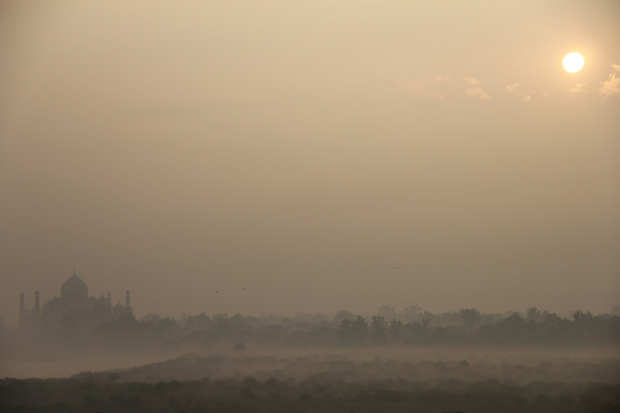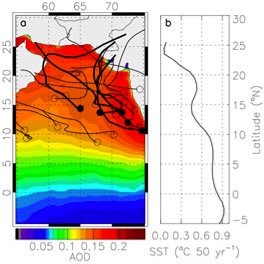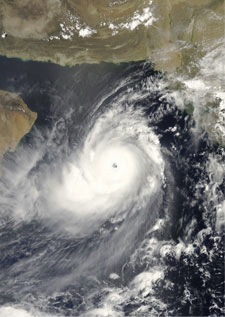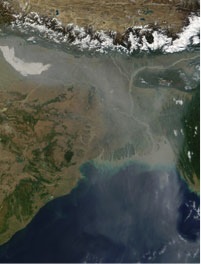By:
- Robert Monroe
Published Date
By:
- Robert Monroe
Share This:
Link Established Between Air Pollution and Cyclone Intensity in Arabian Sea
Disruption of wind shear enables formation of stronger storms, researchers find

The Taj Mahal dimmed by morning smog. Photo: Rebecca Calamar
Pollution is making Arabian Sea cyclones more intense, according to a multi-institutional study that included scientists at UCSD’s Scripps Institution of Oceanography.
Traditionally, prevailing wind shear patterns prohibit cyclones in the Arabian Sea from becoming major storms. A paper appearing in the Nov. 3 issue of the journal Nature, however, suggests the weakening of the winds aloft has enabled the formation of stronger cyclones in recent years — including storms in 2007 and 2010 that were the first recorded storms ever to enter the Gulf of Oman.

Caption: Genesis points (circles) and tracks (solid lines) are of pre-¬monsoon tropical cyclones during the period 1979-2010. Storms with an LMI >100 kt are indicated with a filled circle at the genesis point and thick track lines. The shaded contours represent annual long term mean fine mode aerosol optical thickness (AOT) from the MODIS Terra and Aqua instruments averaged over the period 2003-2009. Figure 1b: The 50-¬year change in observed SST, averaged over 55°-75°E. Image courtesy of Nature
The researchers note that the weakening wind pattern over the past 30 years has corresponded with a buildup of aerosols in the atmosphere over India, which deflect sunlight away from the surface, creating dimming at ground level.
The aerosol buildup creates formations known as atmospheric brown clouds (ABCs) in which smog from diesel emissions, soot and other by-products of biomass burning accumulate and become widespread to a degree significant enough to be a force in regional climate.The three-kilometer (1.9-mile)-thick brown cloud has been linked to altered rainfall patterns in South Asia. Because of the large-scale dimming by the ABCs, they have a mitigating effect on the warming of the ocean in the region that is also associated with greenhouse gas-driven climate changes.
"We're showing that pollution from human activity as simple as burning wood or driving a vehicle with a diesel engine can actually change these massive atmospheric phenomena in a significant way," said study lead author Amato Evan, an assistant professor in the Department of Environmental Sciences at the University of Virginia. "It underscores the importance of getting a handle on emissions in the region."
Historically, the onset of the monsoon season in summer months has produced strong winds in the lower and upper atmosphere that travel in opposite directions, also known as vertical wind shear, which makes formation of cyclones virtually impossible in July and August. Thus despite warm sea surface temperatures, the Arabian Sea averages two or three cyclones per year that tend to form outside the monsoon season, when the wind shear is diminished.

Cyclone Gonu, which produced Category 5 winds in 2007. Photo: NASA/MODIS Rapid Response Team
The researchers note a trend of increasingly strong cyclones in the months immediately preceding monsoon season. A 1998 cyclone that made landfall in Gujarat, India killed nearly 2,900 people. Cyclone Gonu made an extremely rare landfall in Iran in 2007 and caused more than $4 billion in damage. Cyclone Phet in 2010 struck the coastlines of Pakistan and Oman and caused nearly $2 billion in damage. Gonu produced category 5-strength winds in excess of 250 kilometers per hour (156 miles per hour). Phet was a category 4 storm.
"This study is a striking example of how human actions, on a large enough scale, in this case massive regional air pollution caused by inefficient fuel combustion, can result in unintended consequences," said Anjuli Bamzai, program director in the National Science Foundation (NSF)'s Division of Atmospheric and Geospace Sciences, which partially funded the research. "These consequences include highly destructive summer cyclones that were rare or non-existent in this monsoon region 30 or so years ago."
"The research shows that pollution can threaten humans in unexpected ways. In this case, by reducing wind shear in the Arabian Sea and making conditions more favorable for tropical cyclones to intensify," added report co-author James Kossin, a climatologist at the National Climatic Data Center.

The skies over Northern India are filled with a thick soup of aerosol particles all along the southern edge of the Himalayan Mountains, and streaming southward over Bangladesh and the Bay of Bengal. Photo: Jacques Descloitres; MODIS Land Rapid Response Team at NASA GSFC.
The scientists used findings from direct observations and model studies of ABCs made by Scripps Oceanography climate and atmospheric scientist Veerabhadran Ramanathan, a study co-author. Among those findings was that brown clouds inhibited summertime warming of the surface, which caused summertime sea surface temperatures in the northern Arabian Sea to more closely match cooler temperatures closer to the equator. The team modeled the effects of brown clouds on atmospheric and oceanic circulation patterns. They found that ABCs changed the circulation of the atmosphere in such a way as to actually reduce the climatological vertical wind shear.
"This study adds another major dimension to a long list of negative effects that brown clouds have, including rainfall reduction, Himalayan glaciers melting, significant crop damages, and deaths of a million or more annually," said Ramanathan. "The one silver lining is that the atmospheric concentrations of these pollutants can be reduced drastically and quickly using available technologies."
The other co-author of the study is Chul "Eddy" Chung of the Gwangju Institute of Science and Technology in South Korea. The NOAA Climate Program Office provided additional support for the study.
Share This:
You May Also Like
Engineers Take a Closer Look at How a Plant Virus Primes the Immune System to Fight Cancer
Technology & EngineeringStay in the Know
Keep up with all the latest from UC San Diego. Subscribe to the newsletter today.



